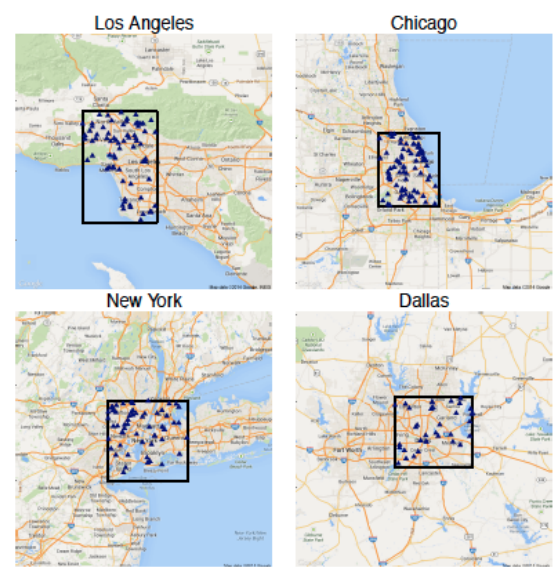Twitter Firehose Reveals How Weather Affects Mood
Researchers have long known that the weather has a profound physiological impact. The human body reacts to sunlight by producing serotonin, a neurotransmitter that is strongly linked with feelings of well-being. Some people are more likely to be depressed during winter, a condition known as seasonal affective disorder or SAD.

But despite this evidence, psychologists have long failed to find a clear correlation between weather and mood. This area of study is littered with studies that show contradictory correlations and others that show no correlation at all.
Now Jiwei Li at Stanford University and a few pals aim to change that. These guys have mined geotagged tweets for indications of mood and then searched for correlations with the weather. They say that some moods are clearly correlated with certain types of weather or changes in the weather but sometimes in counterintuitive ways.
Li and co begin with a database of tweets geotagged to one of 32 major urban areas in the US, such as New York, Chicago, Los Angeles, San Franciso and so on. These had been filtered from a dataset of consisting of 10 per cent of all tweets posted in 2010 and 2011.
Li and co also filtered out tweets about national or international events such as the Haiti earthquake, the death of Michael Jackson and so on. The idea is that people may display strong emotion about these events which are uncorrelated with the weather. So removing these provides access to any underlying link between mood and weather.
The team then categorised the remaining tweets according to four different mood dimensions: anger-hostility, fatigue-inertia, depression-dejection and sleepiness-freshness. Finally, they used a machine learning algorithm to find correlations with the weather in these areas using a database from the National Oceanic and Atmospheric Administration that records the average daily temperature, the daily change in temperature, the daily rainfall or snowfall, the depth of snow, the total amount and strength of the sun each day and so on.
The results make for curious reading. Li and co say that while average temperature does not correlate with mood, a change in temperature does. “People tend to be happier as temperature becomes cooler but feel uncomfortable with drastic temperature decrease,” they say.
Higher temperatures also make people angrier. Snow, on the other hand, is correlated with negative moods.
Li and co also looked for temporal patterns. Most moods follow a weekly pattern with peaks at the weekend. “People tend to be the least angry, the least depressed and the least sleepy on weekends,” say Li and co. However, tiredness follows a different pattern. “The curve of Fatigue-Inertia arrives at its peak on Friday.”
And while common sense might suggest that people tend to be freshest when it is cold, Li and co say their data suggests the opposite. “Cool temperature is linked with sleepiness and people tend to be fresher and fresher as temperature increases,” they say.
These are interested correlations but they come with some important caveats. One is that correlation is not causation. For example, the data shows that snow correlates with negative moods but it is not clear whether this is a result of the weather itself or other things caused by the weather, such as an increase in traffic jams or accidents.
Then there is the bigger question of whether analysing the mood of tweets is a good indicator of people’s real feelings. It’s certainly possible that individuals mask their true feelings on Twitter or deliberately project a persona that differs from their own.
Li and co are well aware of these potential pitfalls and say they are committed to looking for more convincing ways to guard against them in future.
Nevertheless, the geotagged Twitter stream is a valuable source of information that raises interesting questions for future work. In particular, this approach would allow researchers to compare the influence of weather on mood in different parts of the world. It would be interesting, for example, to see whether an increase in temperature changes mood in the same way in the Arctic Circle as it does in the tropics. Or whether there is any cultural variation in the results. Is the effect greater among younger people than older people, for example?
There’s certainly more low hanging fruit in the Twitter firehose.
Ref: http://arxiv.org/abs/1410.8749 : What A Nasty Ay: Exploring Mood-Weather Relationship From Twitter
Keep Reading
Most Popular
Large language models can do jaw-dropping things. But nobody knows exactly why.
And that's a problem. Figuring it out is one of the biggest scientific puzzles of our time and a crucial step towards controlling more powerful future models.
The problem with plug-in hybrids? Their drivers.
Plug-in hybrids are often sold as a transition to EVs, but new data from Europe shows we’re still underestimating the emissions they produce.
How scientists traced a mysterious covid case back to six toilets
When wastewater surveillance turns into a hunt for a single infected individual, the ethics get tricky.
Google DeepMind’s new generative model makes Super Mario–like games from scratch
Genie learns how to control games by watching hours and hours of video. It could help train next-gen robots too.
Stay connected
Get the latest updates from
MIT Technology Review
Discover special offers, top stories, upcoming events, and more.